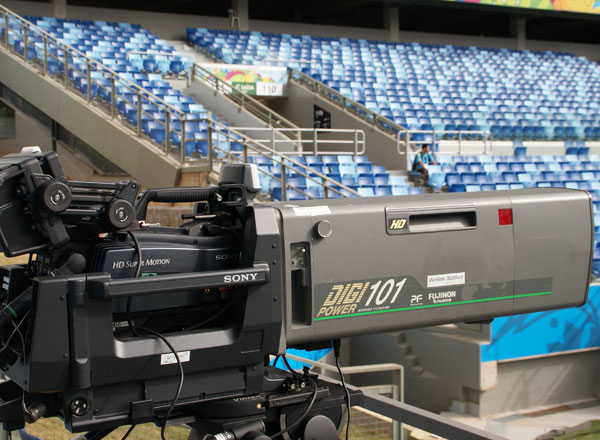Broadcast News
21/06/2018
Ready Or Not, Here AI Comes

Artificial Intelligence (AI) has been around for decades. From virtual assistants on our smart phones and automated transactions in financial services to applications in the defence space, AI is permeating industries at a rapid pace. The broadcast industry is no exception. It's only a matter of time until AI will be as deeply engrained into the production workflow of the broadcast industry as IP or digital solutions are today.
But while there might be consensus about the potential and inevitability of Artificial Intelligence adoption for businesses, an agreed definition of exactly what constitutes AI remains a matter of debate.
There is automation on one hand, which, as the name suggests, is the automation of processes within a system, without human intervention. Equally, there is machine learning, arguably an evolution of automation, which refers to systems that have the ability to automatically learn and improve from experience without being explicitly programmed to do so.
Then there is data analytics, which is the process of examining large data sets to uncover patterns, market trends, correlations or any other useful information hidden in plain sight. A final yet related application of AI is predictive analytics, which extracts information from large data sets to discover patterns and predict future trends and outcomes, and make recommendations.
Definitions cover a whole raft of robotic processing, but automation must not be confused with AI, just as AI must not be thought of as a way to 'get rid of heads'. Automation and AI are both building blocks towards a future with deep learning at its very core. Using intelligence to create new efficiencies, reduce inconsistencies and drive value in places it isn't today.
The AI state of play
Right now, Artificial intelligence is at the start of its adoption curve in the broadcast industry, according to a recent IABM End-User Survey data. Only 8% of media technology buyers said they had adopted it before September 2017. Some 36% said that they were unlikely to adopt it while 56% said that they were likely to do so in the next 2-3 years. Another survey has revealed that two-thirds of organisations that have tested AI, have deployed the technology for at least one critical role in their workflow.
AI is steadily making its way into media production workflows, taking on laborious, expensive tasks like closed captioning, metadata tagging and social media clip generation. For many, the primary driver of adoption of AI technology is the opportunity to automate routine workflows that are manually executed.
Adoption may still be relatively slow, yet one thing is clear: AI technologies are here to stay. The question should not be whether we are going to use AI but rather how we are going to integrate it into what we currently do, from the very start of the production, all the way through to the delivery of the content at the end.
Where the magic lies
Consumer expectations are higher than ever and the demands on broadcast and media companies to provide richer, more personalised services in a continually changing market show no signs of waning. Whether that be personalised recommendations for content people should be watching, the duration of content, or how the actual content is tailored exactly to their needs.
One such factor is network complexity, which is reaching the point where humans simply cannot cope with it. The only way to build a mass-scale video delivery capability, for example, is by pulling more computing to the edge - moving away from simple broadcasting networks and caching content to putting some intelligence firmly at the edge.
Similarly, there's a role for AI in mitigating the huge complexity of programming. It can take up to 18 months from the inception of a creative idea for a programme to be broadcast, during which time the climate the show is being broadcast in may have changed drastically. One way to ensure the content remains relevant is to utilise Artificial Intelligence to help support and make use of complex data analysis to drive better future-looking decisions.
Keeping up with streaming services
Competing with near limitless budgets from the likes of Netflix and Amazon Prime is a challenge facing anyone in today's content game. Broadcasters need to start playing to their strengths, and what they do have in their arsenal is legacy data. Huge amounts of data that can be analysed and used to predict popular programmes, when best to broadcast to increase ratings and many other factors that should be taken into account when making a programme and delivering it to the right audience at the right time.
Calling upon the meta-data is a catalyst towards a richer environment for audiences. Organisations should use it to slowly build up a picture of data, depending on what people want, rather than pushing too much onto audiences to compute. Describing the objects that are in the programme as well as the points of the programme – in other words putting semantic meta-data at people's fingertips – so that people can go directly to that point if they require it. It is about slowly building up a picture of data, depending on what people want and using that to fuel a more familiar viewing experience. When applying this consumer lens, that's when AI gets really smart and creates real, tangible benefits for both companies and end-users.
The same applies to news organisations. If AI can support the news production process by creating and distributing news faster through the use of applications like speech-to-text, facial recognition or edit corrections, then AI will become a real asset to these time-critical industries.
The potential of AI to fundamentally revolutionise and optimise processes in the broadcast sector is near-limitless; its value no longer up for debate. Capitalising on AI in its truest form means leaving aside worries about jobs changing, and focusing instead on the opportunities brought about by having more subject-matter experts to develop and work with a computer system to give better intelligence needed to create and deliver the content people want, when they want it.
The time to embrace AI technologies and stay ahead of the curve is now.
Author: Stuart Almond, Head of Marketing and Communications at Sony Professional Europe
But while there might be consensus about the potential and inevitability of Artificial Intelligence adoption for businesses, an agreed definition of exactly what constitutes AI remains a matter of debate.
There is automation on one hand, which, as the name suggests, is the automation of processes within a system, without human intervention. Equally, there is machine learning, arguably an evolution of automation, which refers to systems that have the ability to automatically learn and improve from experience without being explicitly programmed to do so.
Then there is data analytics, which is the process of examining large data sets to uncover patterns, market trends, correlations or any other useful information hidden in plain sight. A final yet related application of AI is predictive analytics, which extracts information from large data sets to discover patterns and predict future trends and outcomes, and make recommendations.
Definitions cover a whole raft of robotic processing, but automation must not be confused with AI, just as AI must not be thought of as a way to 'get rid of heads'. Automation and AI are both building blocks towards a future with deep learning at its very core. Using intelligence to create new efficiencies, reduce inconsistencies and drive value in places it isn't today.
The AI state of play
Right now, Artificial intelligence is at the start of its adoption curve in the broadcast industry, according to a recent IABM End-User Survey data. Only 8% of media technology buyers said they had adopted it before September 2017. Some 36% said that they were unlikely to adopt it while 56% said that they were likely to do so in the next 2-3 years. Another survey has revealed that two-thirds of organisations that have tested AI, have deployed the technology for at least one critical role in their workflow.
AI is steadily making its way into media production workflows, taking on laborious, expensive tasks like closed captioning, metadata tagging and social media clip generation. For many, the primary driver of adoption of AI technology is the opportunity to automate routine workflows that are manually executed.
Adoption may still be relatively slow, yet one thing is clear: AI technologies are here to stay. The question should not be whether we are going to use AI but rather how we are going to integrate it into what we currently do, from the very start of the production, all the way through to the delivery of the content at the end.
Where the magic lies
Consumer expectations are higher than ever and the demands on broadcast and media companies to provide richer, more personalised services in a continually changing market show no signs of waning. Whether that be personalised recommendations for content people should be watching, the duration of content, or how the actual content is tailored exactly to their needs.
One such factor is network complexity, which is reaching the point where humans simply cannot cope with it. The only way to build a mass-scale video delivery capability, for example, is by pulling more computing to the edge - moving away from simple broadcasting networks and caching content to putting some intelligence firmly at the edge.
Similarly, there's a role for AI in mitigating the huge complexity of programming. It can take up to 18 months from the inception of a creative idea for a programme to be broadcast, during which time the climate the show is being broadcast in may have changed drastically. One way to ensure the content remains relevant is to utilise Artificial Intelligence to help support and make use of complex data analysis to drive better future-looking decisions.
Keeping up with streaming services
Competing with near limitless budgets from the likes of Netflix and Amazon Prime is a challenge facing anyone in today's content game. Broadcasters need to start playing to their strengths, and what they do have in their arsenal is legacy data. Huge amounts of data that can be analysed and used to predict popular programmes, when best to broadcast to increase ratings and many other factors that should be taken into account when making a programme and delivering it to the right audience at the right time.
Calling upon the meta-data is a catalyst towards a richer environment for audiences. Organisations should use it to slowly build up a picture of data, depending on what people want, rather than pushing too much onto audiences to compute. Describing the objects that are in the programme as well as the points of the programme – in other words putting semantic meta-data at people's fingertips – so that people can go directly to that point if they require it. It is about slowly building up a picture of data, depending on what people want and using that to fuel a more familiar viewing experience. When applying this consumer lens, that's when AI gets really smart and creates real, tangible benefits for both companies and end-users.
The same applies to news organisations. If AI can support the news production process by creating and distributing news faster through the use of applications like speech-to-text, facial recognition or edit corrections, then AI will become a real asset to these time-critical industries.
The potential of AI to fundamentally revolutionise and optimise processes in the broadcast sector is near-limitless; its value no longer up for debate. Capitalising on AI in its truest form means leaving aside worries about jobs changing, and focusing instead on the opportunities brought about by having more subject-matter experts to develop and work with a computer system to give better intelligence needed to create and deliver the content people want, when they want it.
The time to embrace AI technologies and stay ahead of the curve is now.
Author: Stuart Almond, Head of Marketing and Communications at Sony Professional Europe
Top Related Stories
Click here for the latest broadcast news stories.
10/02/2025
G42 & AMD To Enable AI Innovation
G42, the leading AI technology group from Abu Dhabi, United Arab Emirates (UAE), announced today a strategic investment in France in partnership with
G42 & AMD To Enable AI Innovation
G42, the leading AI technology group from Abu Dhabi, United Arab Emirates (UAE), announced today a strategic investment in France in partnership with
30/10/2024
Brightcove AI Suite To Be Expanded
Brightcove has announced it will expand its recently launched Brightcove AI Suite with a new AI-Text-to-Video pilot in Q1 2025 and will soon add addit
Brightcove AI Suite To Be Expanded
Brightcove has announced it will expand its recently launched Brightcove AI Suite with a new AI-Text-to-Video pilot in Q1 2025 and will soon add addit
23/05/2024
Advanced Systems Group Launches AI and Advanced Analytics Practice
Advanced Systems Group, LLC (ASG) has launched its 'AI and Advanced Analytics' practice, allowing for delivery of complete AI solutions. The AI team w
Advanced Systems Group Launches AI and Advanced Analytics Practice
Advanced Systems Group, LLC (ASG) has launched its 'AI and Advanced Analytics' practice, allowing for delivery of complete AI solutions. The AI team w
27/06/2024
ITV Appoints New Group Chief Data And AI Officer
ITV has appointed Stefan Hoejmose as its new Group Chief Data and AI Officer, starting on 08 July. Stefan joins ITV from Roku, one of the largest US s
ITV Appoints New Group Chief Data And AI Officer
ITV has appointed Stefan Hoejmose as its new Group Chief Data and AI Officer, starting on 08 July. Stefan joins ITV from Roku, one of the largest US s
14/03/2024
XL8 Named Top AI & Data Product
XL8 has been named a Top AI & Data product in the 2024 Product Awards. The 7th Annual Product Awards, presented by Products That Count in partnership
XL8 Named Top AI & Data Product
XL8 has been named a Top AI & Data product in the 2024 Product Awards. The 7th Annual Product Awards, presented by Products That Count in partnership
03/02/2020
Production News : ITV Appoints New Group Chief Data And AI Officer
ITV has appointed Sanjeevan Bala as its new Group Chief Data & AI Officer. Reporting to Rufus Radcliffe, Chief Marketing Officer and Director of Direc
Production News : ITV Appoints New Group Chief Data And AI Officer
ITV has appointed Sanjeevan Bala as its new Group Chief Data & AI Officer. Reporting to Rufus Radcliffe, Chief Marketing Officer and Director of Direc
07/10/2025
Gcore Launches AI Cloud Stack
Gcore has launched AI Cloud Stack, a next-generation software solution for building private AI clouds with hyperscaler-grade capabilities. The solutio
Gcore Launches AI Cloud Stack
Gcore has launched AI Cloud Stack, a next-generation software solution for building private AI clouds with hyperscaler-grade capabilities. The solutio
02/06/2005
Zimele Broadcasting launches new Ai-Pixel Broadcast solutions in Africa
Ai-Pixel BV, a leading European designer and developer of cost-effective advanced industrial digital video solutions and its South African reseller, Z
Zimele Broadcasting launches new Ai-Pixel Broadcast solutions in Africa
Ai-Pixel BV, a leading European designer and developer of cost-effective advanced industrial digital video solutions and its South African reseller, Z
14/07/2023
Volinga Integrates With disguise For AI-driven 3D Content Creation
disguise's new integration with SaaS platform Volinga.ai enables filmmakers and virtual production specialists to generate 3D environments in minutes.
Volinga Integrates With disguise For AI-driven 3D Content Creation
disguise's new integration with SaaS platform Volinga.ai enables filmmakers and virtual production specialists to generate 3D environments in minutes.
12/08/2019
Vionlabs To Display AI-Powered Content Discovery Platform At IBC 2019
Vionlabs has announced that its AI-powered Content Discovery Platform will make its public debut at IBC2019. The platform enables operators to cut dow
Vionlabs To Display AI-Powered Content Discovery Platform At IBC 2019
Vionlabs has announced that its AI-powered Content Discovery Platform will make its public debut at IBC2019. The platform enables operators to cut dow
21/01/2025
Alibaba Cloud Unveils Latest AI Models, ToolsAand Infrastructure Available
Alibaba Cloud has unveiled an expanded suite of large language models and AI development tools, upgraded infrastructure offerings, and new support pro
Alibaba Cloud Unveils Latest AI Models, ToolsAand Infrastructure Available
Alibaba Cloud has unveiled an expanded suite of large language models and AI development tools, upgraded infrastructure offerings, and new support pro
19/10/2023
Gcore Launches Generative AI Cluster
Gcore has launched its Generative AI Cluster powered by NVIDIA A100 and H100 Tensor Core GPUs. This state-of-the-art AI cloud infrastructure offers ex
Gcore Launches Generative AI Cluster
Gcore has launched its Generative AI Cluster powered by NVIDIA A100 and H100 Tensor Core GPUs. This state-of-the-art AI cloud infrastructure offers ex
10/11/2025
Vizrt Unveils Viz One 8.1
Broadcasters, rights holders, and large media organisations can now locate footage five times faster, tag essential details ten times more efficiently
Vizrt Unveils Viz One 8.1
Broadcasters, rights holders, and large media organisations can now locate footage five times faster, tag essential details ten times more efficiently
10/10/2025
Profuz Digital Reflects On Another Successful IBC Show
Profuz Digital reflects on another successful IBC Show in Amsterdam from 12 – 15 September after showcasing the latest version of subtitling platform
Profuz Digital Reflects On Another Successful IBC Show
Profuz Digital reflects on another successful IBC Show in Amsterdam from 12 – 15 September after showcasing the latest version of subtitling platform
01/08/2025
Profuz LAPIS Powerfully Masters AI-Choreographed Workflow Symphony At IBC2025
European developer Profuz Digital will present at IBC Stand 8.A88, the latest additions in the powerful AI-enabled Profuz LAPIS digital media asset ma
Profuz LAPIS Powerfully Masters AI-Choreographed Workflow Symphony At IBC2025
European developer Profuz Digital will present at IBC Stand 8.A88, the latest additions in the powerful AI-enabled Profuz LAPIS digital media asset ma















